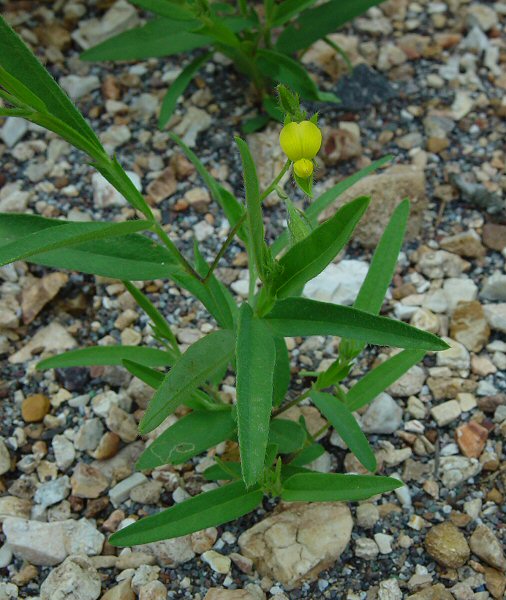Crotalaria sagittalis L.
Rattlebox

Native
CC = 5
CW = 5
MOC = 59
© DETenaglia
Crotalaria sagittalis L.Rattlebox | |
 |
Native CC = 5 CW = 5 MOC = 59 |
© DETenaglia |
|
Family - Fabaceae/Faboideae Habit - Taprooted annual forb. Stems - Ascending to erect, to 40 cm, 2-3 mm wide at base, single or multiple from the base, unbranched or branched, moderately to densely pubescent with long, spreading to loosely ascending, fine hairs mixed with shorter ones. Leaves - Alternate. Petioles absent or to 3 mm long. Stipules absent at the lower nodes, otherwise conspicuous, the free portion 2-7 mm long, narrowly ovate-triangular, tapered to a sharply pointed tip, decurrent basally below the node as a tapered wing of tissue extending to the next-lower node, sparsely to moderately hairy. Leaflets 1.5-5.5 cm long, 0.5-1.5 cm wide, linear to more commonly narrowly lanceolate to narrowly elliptic or (the smaller ones) lanceolate to elliptic, rounded or angled at the base, angled or tapered to a bluntly or sharply pointed tip, sometimes with a minute, sharp extension of the midvein at the tip, the upper surface sparsely to moderately pubescent with long, fine hairs, the undersurface moderately hairy.
Inflorescences - Opposite the upper and median leaves, usually attached on the side of the stem slightly below the leaf node, of solitary flowers or short, clusterlike racemes of 2-4 flowers, the stalk 0.5-3.0 cm long. Bracts and bractlets 4-5 mm long, linear to narrowly lanceolate. Flowers with the stalk 3-8 mm long. Flowers - Calyces moderately to densely shaggy-hairy, the tube 1-2 mm long, the lobes 5-7 mm long, linear to lanceolate. Corollas papilionaceous, yellow, the banner 5-11 mm long, obovate, the wings 4-6 mm long, the keel 4-5 mm long, relatively sparsely hairy along the suture, sharply bent, the tips twisted, forming a short beak. Stamens with the fused portion of the filaments 2-3 mm long, the free portion 3-4 mm long. Anthers yellow, 1 mm long. Style white and green, with some secund antrorse hairs, sharply deflexed. Ovary superior, glabrous, 4 mm long, cylindric.
Fruits - Legumes, 12-30 mm long, 5-12 mm wide, inflated, glabrous at maturity. Seeds 2.3-3.0 mm in longest dimension, the surface greenish brown to brown, smooth and shiny.
Flowering - May - September. Habitat - Upland prairies, sand prairies, glades, forest openings, savannas, talus slopes, streambanks, pastures, fields, mines, quarries, railroads, roadsides, open disturbed areas. Origin - Native to the U.S. Lookalikes - Broadly, Stylosanthes biflora. Other info. - This little species can be found scattered throughout most of Missouri, though it is uncommon or absent in the northwestern portion of the state. Beyond Missouri it also occurs within a broad band extending both northward and southward from the state, and also in northern Atlantic Coastal states. The plant is easily identified even in vegetative condition by its distinctive large stipules with decurrent flaps of tissue extending down the stems. The small, bean-pattern yellow flowers are another strong clue. Photographs taken at Logan Creek, Reynolds County, MO., 6-29-03 (DETenaglia); also at Crowley's Ridge Conservation Area, Stoddard County, MO, 7-17-2009, Tucker Prairie Natural Area, Callaway County, MO, 7-3-2015, Sand Prairie Conservation Area, Scott County, MO, 7-30-2015, and the Edgar W. Schmidt Sand Prairie, Scott County, MO, 7-12-2021 (SRTurner). |